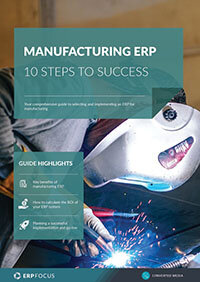Achieving buy-in for your discrete manufacturing ERP project
Often, some kind of emergency will cause a discrete manufacturer to consider a new or upgraded ERP system. For example, the manufacturer might have had trouble managing a prototype project last month causing delays in delivery of the product to the customer. It could be almost any event. But regardless of the straw that broke the legacy system’s back, there are a number of steps you can follow to achieve buy-in for your discrete manufacturing ERP project.
Increasing demands
Many manufacturers can remember how their businesses used to be. They had most of the same customers, and the products were consistent. When changes were needed, they usually had plenty of time to make them. Now, there is a lot more product prototyping and quick delivery of new products. Then, just as quickly, those products are obsolete. Because of this, the pressure to reduce costs never goes away.
Recommended reading: 50-step ERP software selection checklist
It seems that the production schedule changes by the hour. When a deadline is missed by even minutes, everything goes awry. The communication channels seem to be on fire on some days. This part will be early, and that part will be late. One customer wants to pull in their order, and another one wants to push theirs out. One employee takes a sick day, and the business needs a week to recover.
A legacy ERP just cannot keep up with these demands. It worked well ten years ago, but now its grey hair is really thinning. What can you do to justify an upgrade or replacement ERP?
Building a case for system change
Now is the time for you to start looking at the discrete manufacturing ERP systems available today - building up your knowledge of prospective replacement systems is crucial. Meanwhile, start some informal conversations with other departments - *engaging your pool of internal stakeholders early and often will keep your project relevant and front of mind across the business.
You'll need to have the sales, finance, engineering production, materials, and quality departments on board. They will all have concerns and suggestions which will help you create a credible and well supported project outline.
agreeing on the challenges your business faces will create common ground on which to build the project
The conversation could begin with a discussion about how quickly products change today and the demands from customers - agreeing on the challenges your business faces will create common ground on which to build the project. Your next ERP will need to be more agile and flexible. It must allow you to keep your core competencies efficient and not bog the business down in areas where your existing processes are working well.
Call a meeting in the next few days to get started. This meeting should begin a thorough requirements analysis phase in which you analyse key processes for strengths and weaknesses, allowing you to pinpoint areas for improvement. Once you get a preliminary list of requirements, you can start monetizing them and forecast return on investment for the project. Only then will you have the tools to inspire buy-in for your discrete manufacturing ERP project.
Free white paper

Manufacturing ERP: 10 steps to success
Complete step-by-step guide to manufacturing ERP software

Featured white papers
-

7 steps to selecting discrete manufacturing ERP
17 pages of ERP selection advice and industry requirements analysis
Download
Related articles
-

How to identify the best ERP for your discrete manufacturing business
Learn about the best practices associated with selecting a discrete manufacturing ERP system for ...
-

Secret KPI: Why Your ERP Implementation Team Matters More Than Software
Learn how Godlan ensures successful ERP implementation for manufacturers with proven strategies &...
-

A compliance checklist for medical manufacturing ERP
These are the compliance requirements your medical device manufacturing ERP should help you meet

